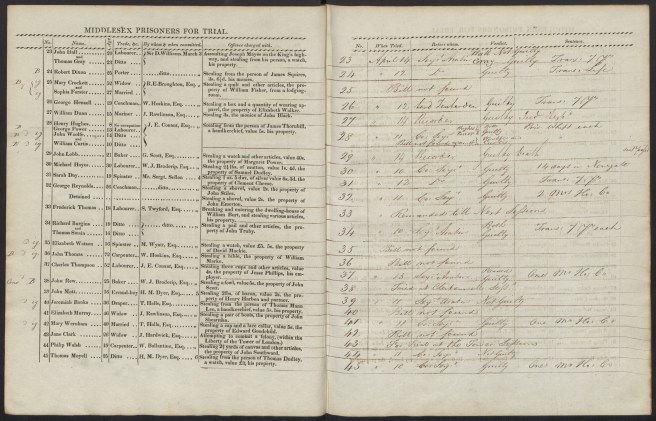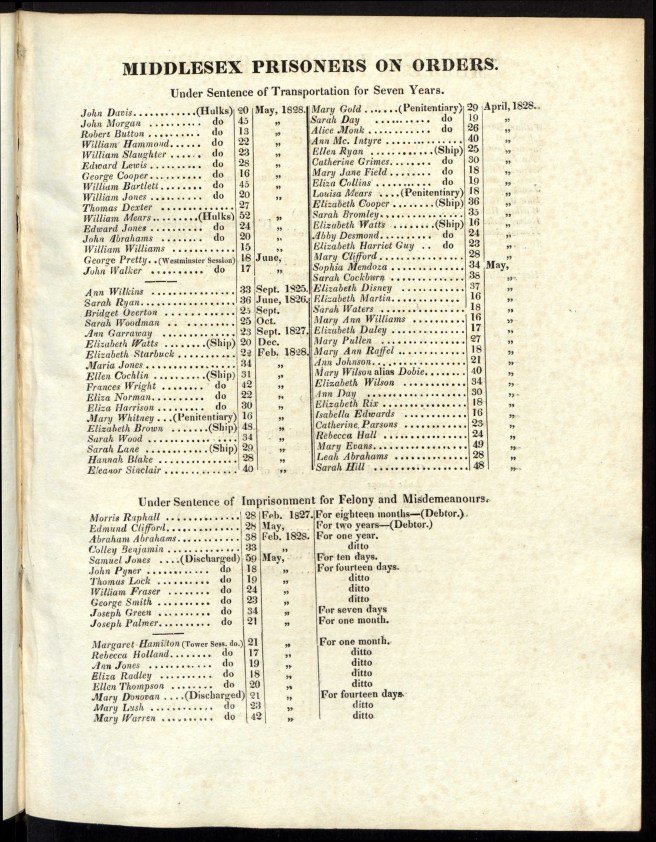Welcome to Week 33 of my Genealogy challenge, from the wonderful Amy Johnson Crow, of writing something about your Ancestors for a whole year, #52Ancestors in 52 weeks. This week’s prompt is ‘Troublemaker’.
We all like the idea of finding a ‘Loveable Rogue’ on our Family Trees, maybe a bit of a naughty lad ,who’s had a few brushes with the Law. After all it makes our Tree all the more interesting.
My so called ‘Troublemaker’ is actually a Young Woman called Sarah Day.
Sarah was the oldest of Four Children born to George and Sarah Day and she was born in Vineyard Gardens in Clerkenwell in 1809. She was later Baptised with her two Siblings, George Edwin Day and Henry James Day on 27th March 1815 at St. James Church Clerkenwell.

Sadly the story for Sarah is a somewhat limited one, unfortunately somewhere along the way, our Sarah lost her way slightly, whether it was necessity, or whether it was greed, we will never know the full story, of what lead to her fall from grace.
Here is the account of The Old Bailey Proceedings dated 10th April 1828.
SARAH DAY was indicted for stealing, on the 3rd of March , 1 oz. and 5 dwts. of silver, value 6s. , the goods of Clement Cheese .
CLEMENT CHEESE. I am a silversmith, and live in Clerkenwell, the prisoner was in my service. On the 1st of March I found I was deficient in my stock and on the 3rd I was deficient again; I told her on the Sunday that I was deficient, and I would know who it was. On the Monday I told her I was short again, and I would see in her box; she said, she was never called a thief before, I said, if she had nothing of mine, she could not object to my seeing her box; she hesitated. I went up stairs with my errand-boy; she opened her box and took out a small paper parcel, which she tried to put into her pocket, the boy stopped her hand, and we found it was this piece of silver. I told the boy to empty out the box, and we found some more silver, she fell on her knees and begged forgiveness; here is an ancient coin among it, which I know well, and a piece of an ingot; she only lived eleven days with me, and came from the office in Holborn. (Property produced and sworn to.)
BENJAMIN DUKE . I am Mr. Cheese’s errand-boy; I saw the silver found in the prisoner’s box, she asked forgiveness.
WILLIAM BROWN EDWARDS . I am an officer and took her in charge.
GUILTY . Aged 19.
Transported for Seven Years .
Transportation was often a punishment given to people found guilty of theft and 80 per cent of transported convicts were guilty of theft. Most were repeat offenders. Transportation was seen as a solution to the rising crime in Britain in the 1800’s and courts were looking for a punishment which was not as extreme as hanging, but tougher than a fine. Transportation had been used as a form of punishment since 1717
With many prisons full – sending criminals to Australia seemed an option. Over period of 80 years, more than 165,000 convicts were transported to Australia. At first convicts were kept on old warships where one in three died because of terrible conditions. Many were sent to America and later to Australia. Seven out of eight of these people sent to Australia were males; some were as young as nine or ten; some were over eighty.
Once in Australia, convicts lived in barracks and worked in gangs, building roads and bridges or working on farms or quarries. Some were sent out to work for farmers. If they behaved themselves, their sentence could be reduced by a ‘ticket of leave.’ The majority of convicts decided to stay in Australia at the end of their sentences, recognising that they could make a better life there than returning to Britain and, probably, poverty and crime.
This quote on the National Library of Australia web page sums up Sarah Day’s circumstances perfectly.
“Female convicts were predominantly young, single women who had been domestic servants and/or who had come from a semi-skilled background – such as an apprenticeship. The majority of female convicts were first time offenders sentenced to transportation for minor theft (Oxley, Deborah, Convict maids 1996 , pp. 42-48).”



The above record shows that Sarah Day was held in a Penitentiary rather than a Prison Hulk.
There is a petition registered for Sarah Day in The Home Office Criminal Petitions:
“Received here, 14th June, following her time expires 27th April 1833”.

So it would appear from the above Petition record, that Sarah Day appealed against her harsh sentence of 7 years Transportation, which was upheld and her imprisonment ended on 27th April 1833.
Of the main players in this story, the Officer in Charge, William Brown Edwards is stationed at the Hatton Garden Station and appears in several other Old Bailey proceedings. Clement Cheese appears as a Juror in 1827 and Benjamin Duke disappears without a trace.
Clement Cheese was a specialist Master Spoonmaker whose work now, is highly collectable, see the eBay listing Here (details added thanks to the sharp eye of Stephs Family History, her blogsite can be found Here
I initially thought that finding these records and finding out more about what happened to Sarah was going to be relatively straight forward, but far from it. There is no mention of the trial, that I can find in any of the Newspapers and subsequently it’s proved hard to establish anymore records for Sarah Day. Given I have only been looking at Sarah’s story for a week, I am sure that there are lots more to uncover about what happened to her.
So keep an eye out for Part Two of this story
So in keeping with the theme, Sarah Day has been a ‘Troublemaker’, in more ways than one!
All My Blogs For Family Tree Magazine in one Handy Place


I wonder how Sarah intended to turn the silver into useful money.
LikeLiked by 1 person
I thought that as well or was it a magpie thing and she saw it and just took it and never thought things through. Or was she a petty thief that had an outlet already???
LikeLiked by 1 person
You’re finding some truly intriguing stuff here. Thanks for sharing.
LikeLiked by 1 person
Thanks Mason, there’s lots more to discover here as well I’m sure. It’s also my first venture into an ancestor sentenced to transportation so I’m still learning new things even at my age!
LikeLiked by 2 people
That’s the coolest thing about this sort of research I think. There’s always something new to find. My author friend Ashlie Harris here at the link below is great at Ancestry research if you get stuck too.
https://ashlieharris.wordpress.com/
LikeLiked by 1 person
Spot on, you just never know what you’re going to find and it’s all part of the fabric that makes us who we are. Thanks for the mention of Ashlie I will be sure to message her when I’m stuck, thanks
LikeLiked by 1 person
For sure it becomes an adventure of its own.
You’re welcome. She’s a master at finding information on ancestry.
LikeLiked by 1 person
Interesting to see that Clement Cheese was a master spoon-maker and one of his pieces on ebay!
( https://www.ebay.co.uk/itm/Antique-Spoon-Georgian-Sterling-Silver-ca-1830-Clement-Cheese-Solid-English-UK-/172712243727 )
LikeLiked by 1 person
I knew he was a Silversmith but hadn’t seen the eBay entry, so will add that to his story, thanks Steph.
LikeLike
Brilliant Detective work Steph thank you, have updated the blog and added a link to your blog as well in the story
LikeLike
Glad to help. At least Silversmiths left their “mark”; good luck with tracing Sarah’s journey.
LikeLiked by 1 person
Good point! Thanks again
LikeLike
Wow, Sarah’s trip to Australia must have been filled with trauma. Not easy times at all…
LikeLiked by 1 person
I’m sure that she never actually left these shores Andi, she was sentenced to 7 years transportation but petitioned against the sentence and was released in 1833, from what I can tell.
LikeLiked by 1 person
Aaah ha! Speed reading really sucks! I will blame my haste on John today! Hoping all is well with you!
LikeLiked by 1 person
All good here thanks Andi, we’ve all got a week off but weathers lousy, did manage a walk today though to the River to feed the ducks
LikeLiked by 1 person
What a fascinating story! Thank you for a great read, and some really interesting visuals!
LikeLiked by 1 person
Thank you Rose I am glad that you enjoyed the story
LikeLike
Really interesting story! It seems her master wanted to give her a chance but she didn’t take it. She was lucky not to get transported. Hopefully, her life turned out well afterwards.
LikeLiked by 1 person
As with all things family history related Jude, the more answers we find, the more questions they raise
LikeLiked by 1 person